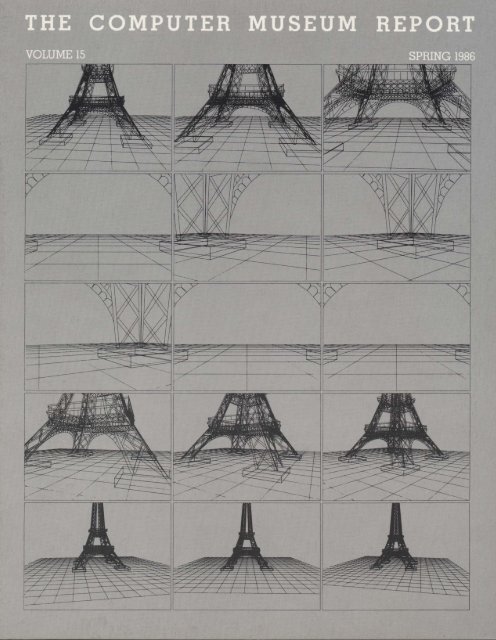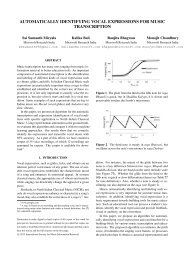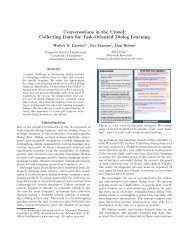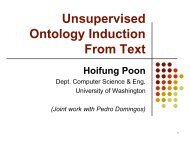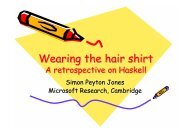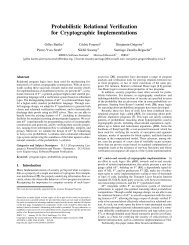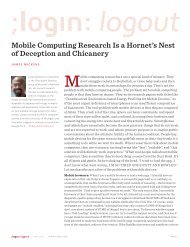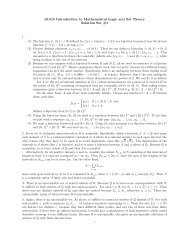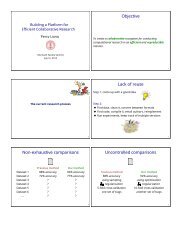TCM Report, Spring - Microsoft Research
TCM Report, Spring - Microsoft Research
TCM Report, Spring - Microsoft Research
Create successful ePaper yourself
Turn your PDF publications into a flip-book with our unique Google optimized e-Paper software.
Contents<br />
The President's Letter<br />
Dr. Gwen Bell<br />
2 The Museum Mouseathon<br />
S From the First IS-bit Mini to<br />
Fault Tolerant Computers<br />
Gardner Hendrie<br />
10 Classic Film Clips Showing<br />
Computing from 1920 to 1980<br />
14 A Real-Time Event<br />
IS Computer Graphics Image<br />
Contest<br />
17 <strong>Spring</strong> Program Series<br />
Calendar<br />
Cover<br />
Ellie. by Keith Waters, first stude nt<br />
place in the Ca lComp Interna tional<br />
Computer Art Competition. Winners on<br />
display at the Museum Fe bTuary 1-<br />
March 30 1986.<br />
The Computer Museum<br />
The Computer Museum IS a non-proht<br />
501(c)3 foundatton that chromcles the evolution<br />
of informahon processmg through<br />
exhibitions, archives, publications, research,<br />
and programs.<br />
Museum Hours: The Museum hours are 10 AM-<br />
6 PM, Tuesday, Wednesday, Saturday, and<br />
Sunday and !O AM-9 PM, Thursday and FrIday<br />
It IS closed Mondays, ChrIstmas, New<br />
Years, and Thanksgiving.<br />
Membership: All members receive a<br />
membership card, free subscription to The<br />
Computer Museum <strong>Report</strong>, a 10% discount on<br />
merchandise from The Computer Museum<br />
Store, free admission and invitations to Museum<br />
previews. For more informahon, contact<br />
MembershIp Coordinator at The Computer<br />
Museum, 300 Congress Street, Boston, MA<br />
02210, (617) 426-2800.<br />
Staff<br />
Dr. Gwen Bell. President<br />
Michael Templeton. Director<br />
Dr. Oliver StrimpeI.<br />
Associate Director and Curator<br />
Kurt leVitan, Exhibit Specialist; William Wisheart,<br />
Registrar; Terry M ullins. Education Coordinator;<br />
Gregory Schroeder. Reservationist; Gregory<br />
Welch, <strong>Research</strong> Assistant.<br />
Mark Hunt. Marketing Director<br />
Louise Domenitz, Public Relations Manager;<br />
Jessica Pollard, Communicahons Assistant;<br />
Kathleen Keough, Functions Coordinator.<br />
Michael Oleksiw. Development Director<br />
Anne lenckes. Development Assistant;<br />
Scott Reilly, Membership Coordinator;<br />
Linda Clingan. Museum Benefits Coordinator.<br />
Eva Radding, Business Manager<br />
Lea Cohen, Store Manager; Steven Klinke,<br />
Assistant Store Manager; Stephanie Finley,<br />
ASSistant to the Store Manager; Nancy Dattero.<br />
Office Manager; Deborah Goudreault. Business<br />
Office Assistant.<br />
GermainDRK<br />
Public Relations Advisors<br />
Benson Clemons Design<br />
The Presidentls Leiter<br />
Dear Members,<br />
The Museum has now been open for one year. A year in which we have<br />
learned a great deal about our potential and our members' interests. We<br />
hope to put that knowledge to work in order to serve you better: putting on a<br />
wide variety of programs; scheduling special temporary exhibitions; holding<br />
innovative fund-raisers; and offering new products in our store that let<br />
you "have a bit of the Museum" for yourself, wherever you are.<br />
Our program series, founded to serve our membership and attract the<br />
attention of the public, has also diversified. For the Fourth of July we put<br />
on our first Computer Animation Festival and had one of our best attended<br />
afternoons ever. Our winter program series features a Thursday evening<br />
film series. A simple talk on "micromice" escalated into the first Boston<br />
Mouseathon, described by Oliver Strimpel in the first article. Museum<br />
founder Alan Frisbie from Los Angeles wandered in for a visit and ended up<br />
spending the whole day! The event turned out to be a real "crowd please"<br />
and boost for micromouseketeering. The February Kids Computer Fair<br />
brought widespread participation from schools, user groups, educational<br />
software developers and Museum enthusiasts.<br />
We also "fell into" doing temporary exhibitions with a show of the original<br />
artwork for BYTE magazine covers by artist Robert Tinney. This was so well<br />
received that we kept the show on display in the space near the auditorium<br />
until we could fill it with something else. It came down in mid-January in<br />
time for the January 31st opening of "The Electronic Paintbrush." The cover<br />
of this report features one of the works from this exhibition. The result of a<br />
competition sponsored by CalComp in honor of their 25th anniversary, the<br />
exhibition was first displayed at the California Museum of Science and<br />
Industry. It will be here until March 31. "Colors of Chaos," an extraordinary<br />
set of computer generated fractal images, will be on view from April 10th<br />
through June 15th. The space works for such exhibits and we welcome your<br />
suggestions for others that might be appropriate for the Museum to show.<br />
Before we moved, the annual benefit was established. Now our fundraising<br />
efforts have also grown and diversified. The Marlboro "yard sale"<br />
was transformed into an even more successtul "attic sale" appealing to<br />
both collectors and tinkerers. In December, the Museum held "A Real-Time<br />
Event" -a truly unique fund-raiser as described later in this report issue.<br />
February's Fortieth Birthday Party for ENIAC was inspired by member<br />
Annie Roe-Hafer and heavily supported by Bitstream, Inc. a corporate<br />
member. June 8th will bring our annual gala with the Board of Directors<br />
and another chance to hear from one of them on the state of computing.<br />
Each of these events are fund-raisers and fun-raisers that appeal to different<br />
parts of the Museum's audience, and allow a great deal of interaction<br />
between members and the staff.<br />
Finally, we have produced a Videotaped version of the "See It Then" theater<br />
at the Museum. This film has gotten such good reviews for providing a<br />
quick and fun overview of the history of computing that we had to make it<br />
available, especially for everyone who teaches and can't bring their<br />
classes to the Museum. If a picture is worth l.000 words, then this videotape<br />
is worth a 100,000 word reading assignment.<br />
The suggestion box is open. Most of these ideas came to us from members<br />
and then they grew. In reviewing this list. it's clear to me that the Museum<br />
has an important membership. We're here because you are too.<br />
Gwen Bell<br />
The Computer Museum <strong>Report</strong>/<strong>Spring</strong> 1986 I
The Museum Mousealhon<br />
Origins<br />
It all began with a 1977 announcement<br />
in Spectrum magazine that the time<br />
was ripe for microprocessors to put on<br />
wheels for a self-controlled ride. The<br />
challenge was to build a mouse that<br />
could find its way to the heart of a<br />
maze, remember it, and then run the<br />
course as fast as possible. The IEEE<br />
Computer Society formalized the competition,<br />
specifying maze and mouse<br />
dimensions, and trials took place<br />
throughout 1978 with a final race at the<br />
National Computer Conference in 1979.<br />
The winner was the only mouse among<br />
the 24 entrants that made it to the<br />
finish! The rest of the entrants got stuck<br />
or confused, or just failed to start. But<br />
the contest looked like fun. These<br />
small mobile robots require hardware<br />
for propulsion, steering, guidance,<br />
wall and track sensing and software<br />
for mapping and strategy. The fixed set<br />
of rules constrains the problem and the<br />
contest provides a quantitative measure<br />
of progress.<br />
International Micromouse Racing<br />
The idea has taken off in Europe and<br />
Japan. Under the impetus of Dr. John<br />
Billingsley, mice from the UK, Finland,<br />
West Germany, Switzerland have competed<br />
in European championships<br />
held every year since 1980.<br />
Since the first Japanese micromouse<br />
contest in 1980, the Japan Micromouse<br />
Association has grown to 800<br />
members spread throughout the country.<br />
The association has a permanent<br />
board of directors, consisting of senior<br />
academics, industry executives and<br />
officials of the Japan Science Foundation.<br />
A bimonthly magazine 'Mouse'<br />
is published, covering micromouse<br />
events worldwide.<br />
In 1985 the Japan Micromouse<br />
Association held a World Micromouse<br />
Contest coinciding with the<br />
World Expo in Tsukuba City, Japan.<br />
With support from the Japan Science<br />
Foundation and NAMCO Ltd., the Japan<br />
Micromouse Association invited<br />
teams from Britain, Finland, Germany,<br />
South Korea and the United States to<br />
compete. It soon became clear that the<br />
visiting mice were no match for the<br />
Japanese entrants. The first five prizes<br />
all went to mice from a single Japanese<br />
microcomputer club-the Fukuyama<br />
Club, from Hiroshima Prefecture.<br />
Micromice in the US<br />
Although the idea originated in the<br />
United States in 1977. it has not caught<br />
on. In 1984, in an effort to rekindle US<br />
interest, the Japan Micromouse Association<br />
presented the IEEE Computer Society<br />
with an official micro mouse maze<br />
for use in the US contest where participants<br />
in the world contest would be<br />
selected. Mappy, the official mouse of<br />
the Japan Micromouse Association<br />
was loaned together with the maze. In<br />
the <strong>Spring</strong> of 1985, The Computer Museum<br />
and the IEEE Computer Society<br />
agreed to site the maze at the Museum,<br />
develop a micromouse exhibit and<br />
hold a special inaugural event.<br />
The Museum Event<br />
Dr. Peter Rony of the IEEE Computer<br />
Society and Dr. John Billingsley from<br />
Portsmouth, England kicked off the<br />
Museum's race week with a lecture/<br />
demonstration on Sunday, November<br />
17. Dr. Billingsley demonstrated three<br />
mice he had brought from England.<br />
A group from The Japan Science<br />
Foundation, NAMCO and the Fukuyama<br />
Club were also invited. Mr.<br />
Hirofumi Tashiro, Secretary General of<br />
the Japan Micromouse Association<br />
and Manager of the Director's Office at<br />
NAMCO Ltd. led the group. Three<br />
members of the Fukuyama club came:<br />
Mr. Masanori Nomura, a trained veterinarian,<br />
Mr. Masaru Idani, system<br />
technical researcher for Japan System<br />
Design Co. Ltd. and Mr. Eiichi<br />
Fujiwara. The IEEE Computer Society<br />
arranged for Mr. Key Kobayashi, an<br />
interpreter to attend.<br />
The Inaugural Run<br />
John Billingsley's three English mice<br />
rapidly cleared customs at Logan airport<br />
in Boston where they are used to<br />
seeing weird electronic contraptions.<br />
'Thumper', the 1981 European champion<br />
by David Woodfield, runs on four<br />
wheels and turns by swivelling his<br />
wheels, not by rotating the whole body.<br />
His large and heavy frame tends to<br />
thump the walls, hence the name. His<br />
ability to talk, apart from being very<br />
funny, is used for diagnosis. 'T6', the<br />
latest in a series of 'Thezeus' mice by<br />
Alan Dibley, and 'Enterprise', the 1984<br />
European Champion by David Woodfield<br />
are both three-wheeled mice with<br />
DC motors to provide propulsion on the<br />
back wheels and an optical distance<br />
counter on the steered front wheel. All<br />
three use the Z80 microprocessor.<br />
Though delicate, the mice survived<br />
the journey intact, and they were<br />
The 1985 World Micromouse Contest<br />
at Tsukuba Fifteen contestants from<br />
5 overseas countries and 120 from<br />
Japan competed.<br />
The Computer Museum <strong>Report</strong>/<strong>Spring</strong> 1986 3
checked out on a trial maze. It soon<br />
became apparent that Thumper was<br />
most confused, and T6 was steering<br />
straight into the walls. Preferring not<br />
to attribute this performance to jet lag,<br />
we suspected that the maze itself was<br />
not giving the infrared signature required<br />
by the mice. The mice detect the<br />
walls by using active infrared sensors<br />
that stick out above the walls of the<br />
maze and look down. The tops of the<br />
walls are meant to be reflective in<br />
infrared (around one micron wavelength)<br />
and the black floor of the maze<br />
is meant to absorb infrared. However,<br />
the floor of the maze, though black,<br />
looked rather shiny in the infrared, so<br />
after obtaining permission from the<br />
IEEE Computer Society, we covered the<br />
maze floor with a thick coat of the<br />
matt est black emulsion we could find.<br />
Thumper and T6 still occasionally<br />
went 'blind', so we began to suspect the<br />
walls. Using Thumper as an infrared<br />
reflectometer, we found that the dull<br />
red plastic layer that covered the tops<br />
of the walls was actually a very poor<br />
reflector of infrared. So we covered all<br />
the wall tops with strips of highly infrared<br />
reflective red sticky paper, and<br />
this solved the problem.<br />
At the start of the Sunday lecture,<br />
Peter Rony spoke on behalf of the IEEE<br />
Computer Society, presenting the<br />
Museum with the loan of the official<br />
maze, and encouraging future mousebuilding<br />
activities in the US. John<br />
Billingsley then described the history<br />
of European micro mouse events and<br />
demonstrated the three English mice.<br />
Thumper, though slow and lumbering,<br />
makes up for it by his speech, saying "I<br />
will find the shortest route" as he pulls<br />
off from the start. Apparently at random,<br />
he sings out with a repertoire<br />
consisting of remarks such as 'I hope<br />
there are no cats in here', 'my work is<br />
never done' and 'I could do with a restmy<br />
wheels are killing me!' When comparing<br />
Thumper to the later mice, it's<br />
hard to believe that he is more than all<br />
talk and no action-he was actually<br />
the European champion in 1981.<br />
Enterprise and T6 learn the maze<br />
after relatively little exploration and<br />
take advantage of the straight passages<br />
with bursts of acceleration.<br />
The Mouseathon<br />
After 21 hours in the air, the Japanese<br />
participants arrived late on the Thursday<br />
before the Saturday event. Refreshed<br />
the following morning, they<br />
unpacked their mice-all members of<br />
the 'Noriko' series. The older Xl and X2<br />
performed well at once, but X3 and X4<br />
seemed a bit worse off for the long<br />
4 The Computer Museum <strong>Report</strong>/<strong>Spring</strong> 1986<br />
After a burst of speed down a straight,<br />
T6 brakes just in time to round a corner.<br />
Mr. Tashiro watches Mappy at the<br />
maze's start NAMCO, a large manufacturer<br />
of computerised games and<br />
toys, built 10 identical show mice in<br />
1981 to promote interest in micromouse<br />
racing. Modelled after a popular Japanese<br />
cartoon character, Mappy plays<br />
the role of a mouse policeman, scouring<br />
every alleyway of the maze to find<br />
a troublesome stray cat. With siren<br />
blaring and baton waving, he bears<br />
down on the center of the maze where<br />
he spins around to burst a balloon with<br />
a pin mounted on his tail. Then he<br />
races back to the starting square, sirens<br />
still blaring and lights flashing, and<br />
shouts "1 got 'em!" in Japanese.<br />
Mappy will be demonstrated regularlyat<br />
the Museum while on loan<br />
fromNAMCO.
traveL and needed some attention<br />
from the chief engineer, Mr. Idani.<br />
An enthusiastic crowd of over 400<br />
people showed up for the event.<br />
Throughout the morning and early afternoon<br />
time-trials were held. Each<br />
mouse had fifteen minutes in which to<br />
make its best run to the center (see<br />
rules box). All mice completed the<br />
maze, except for Noriko X4 which never<br />
really got going. Noriko Xl came in<br />
fastest, at 14.8 seconds in contrast to<br />
Thumper who managed to talk his way<br />
through the maze in 3 minutes. Mappy<br />
performed a couple of his noisy runs,<br />
greatly entertaining the audience.<br />
The race's judges then took their<br />
places: Susan Rosenbaum, governing<br />
body member of the IEEE Computer<br />
Society and volunteer in charge of US<br />
micromouse activities, affectionately<br />
known as 'micromom', Gwen Bell, the<br />
Museum's president, Hirofumi Tashiro<br />
and John Billingsley.<br />
The maze was changed to make<br />
sure that memories of the time-trial<br />
maze could not give any mouse an<br />
unfair advantage and the race then<br />
began with the mice competing in the<br />
order in which they qualified.<br />
Noriko X4 still failed to wake up,<br />
but X3 completed a run in just over 13<br />
seconds. Next, Thumper talked his<br />
way into the corners, so badly out of<br />
alignment that he had to be retired. T6,<br />
which must be the quietest mouse ever<br />
built, came in at 37.2 seconds. Enterprise<br />
performed reliably again, never<br />
slipping or needing any kind of adjustment.<br />
But his time of 28.1 seconds<br />
proved no match for the Japanese.<br />
Now the two fastest Noriko's<br />
battled it out. Although the Noriko<br />
mice carry out a lot of apparently redundant<br />
maze exploration at the outset,<br />
they make up for it with speed and<br />
Judges Susan Rosenbaum (left), Gwen<br />
Bell (center), and Hirofumi Tashiro<br />
with John Billingsley commentating.<br />
cornering agility once they find the<br />
shortest routes. It was breathtaking to<br />
watch the slalom as they swung<br />
aroung the final zig-zags towards the<br />
finish. Several times the Noriko's got<br />
stuck a hair's breadth from the finish<br />
and had to be carried back to the start.<br />
In the end, powered by a freshly inserted<br />
heavy duty Nicad battery pack,<br />
Xl made a lightning fast run of only<br />
10.85 seconds, just over half a second<br />
faster than X2's best run of 11. 55<br />
seconds.<br />
Gwen Bell awarded the prizessilicon<br />
wafer pendants, hung around<br />
the necks of the human participants,<br />
not the mice.<br />
The Future<br />
The Museum will hold more races<br />
when new mice come forward to challenge<br />
the Japanese and Europeans.<br />
There are encouraging signs-several<br />
groups took notes at the races, saying<br />
they planned to build micromice with<br />
better maze-solving strategies. For<br />
After the award giving, from left<br />
to right: Eiichi Fujiwara, Masanori<br />
Nomura, fohn Billingsley; Oliver<br />
Strimpel, Masaru Idani. Mr. [dani and<br />
Mr. Fujiwara hold 1st and 3rd place<br />
winners, Norikos Xl and X3. The<br />
Noriko series employs a 'wheelchair'<br />
drive: two wheels have drive motors<br />
and steering is accomplished by driving<br />
them at different speeds. Fore and<br />
aft are wheels, castors or skids to provide<br />
stability. The newer Noriko's are<br />
DC motor driven, the older ones using<br />
stepper motors. A home-made position<br />
those who want to try their hand at the<br />
software side of micro mouse racing,<br />
NAMCO Ltd. makes a kit that can<br />
be purchased via the IEEE Computer<br />
Society.<br />
John Billingsley is now promoting<br />
robot ping-pong, or 'robat'. Contestants<br />
mount their players at either end<br />
of a special table with controlled lighting<br />
and a mechanism to serve the ball.<br />
The players essentially consist of a bat<br />
fixed to an x-y plotter mounted vertically<br />
together with a vision system.<br />
The Museum plans to collect<br />
micromice and provide a venue for<br />
future international sporting events!<br />
IEEE Spectrum © 1985. Photographer: Malcolm Hewitt<br />
gyroscope with its axis mounted horizontally<br />
gives the mouse an accurate<br />
measure of how much it has turned, a<br />
critical piece of information when the<br />
wheels are liable to skid during very<br />
rapid cornering. These mice also have<br />
easily inserted ROMS, used to give the<br />
mouse different strategies, depending<br />
on the maze. ROM-swapping and<br />
tweaking of potentiometers.is not allowed<br />
in European contests where a<br />
more rigorous criterion of micromouse<br />
self-sufficiency is applied.<br />
The Computer Museum Re port/<strong>Spring</strong> 1986 5
A Personal Odyssey<br />
Throughout my career as a computer designer. I<br />
have set out on explorations into the unknown. Over<br />
and over again I undertook the design of new computers<br />
without the foggiest idea of how to do it.<br />
Over the last twenty years. I was involved with three<br />
different machines at three different companies. In<br />
what follows. I have corrected all the dollar amounts<br />
for inflation so that direct comparisons can be made.<br />
From the First 16·bit Mini<br />
to Fault Tolerant Computers<br />
Gardner Hendrie<br />
• The Computer Museum <strong>Report</strong>/<strong>Spring</strong> 1986<br />
1964: The First 16-bit Mini<br />
In 1964, three companies competed in<br />
the mini-computer market, even<br />
though the name had not yet been<br />
invented and they were called realtime<br />
control computers. DEC did $37<br />
million in business; Computer Controls<br />
Corporation (CCC) $50 million;<br />
and Scientific Data Systems (SDS) $67<br />
million business. SDS which grew to<br />
$134 million in the next year, was<br />
clearly the successful company of the<br />
three. Then in the late sixties, SDS was<br />
bought by Xerox for about a billion<br />
dollars and became SDX. In the sixties,<br />
Xerox disbanded this fairly expensive<br />
experiment. In 1965, CCC was<br />
purchased by HoneywelL surviving<br />
until the early seventies when it disappeared<br />
into the larger organization.<br />
In 1964, DEC was selling the PDP-5,<br />
the precursor of the PDP-8, for $95,000.<br />
CCC was selling the DDP24, and SDS<br />
the SDS 910 and 920, each for about<br />
$300,000. The machines had 8K bytes<br />
of memory and the basic i/o device was<br />
the flexowriter, the precursor of the<br />
ASR 33 teletype which provided a keyboard,<br />
a printer, and a paper tape<br />
puncher and reader. Software existed<br />
but was not elegant. The operating<br />
systems would run on 4K words of<br />
memory and on a FORTRAN compiler<br />
with 8K words. Back-up storage was<br />
done on magnetic drums that ranged<br />
between 32,000 and a million bytes.<br />
At that time, I had been earning a<br />
living for ten years as an engineer. My<br />
inflation adjusted salary was $65,000.<br />
If you look at salaries today they are<br />
equivalent. A VW bug cost just over<br />
$5,000. A lot of things stay the same<br />
forever, adjusted for inflation.<br />
I had designed an industrial control<br />
computer for a division of RCA that<br />
ceased to exist two years after the<br />
computer was built. When I designed<br />
that machine, I had never designed or<br />
even worked on the design of a digital<br />
computer before, nor had I taken a<br />
course in digital computers. I did have<br />
an elementary course where I learned<br />
plug board programming on an old<br />
Burroughs machine, so I had some<br />
vague idea of the basic principles of<br />
computers. The experience was my<br />
education. The computer seems absolutely<br />
prehistoric by today's standards.<br />
It took 56 microseconds to add two 24bit<br />
numbers and cost roughly half a<br />
million dollars. NASA used this machine<br />
for checking out the main Saturn<br />
booster stage on the Apollo missions.<br />
Lowell Bensky, whom I had<br />
worked for at RCA when I was out of<br />
college, asked me to join CCC. The VP<br />
of marketing at CCC believed that if<br />
we could build a $75,000 computer to go<br />
along with the $300,000 DDP24, a lot<br />
more machines would be sold. I left<br />
Foxboro to build that machine for<br />
CCC. At the time, the competition was<br />
the PDP-5 and CDC's 160. In my view,<br />
the CDC 160 with its short word length,<br />
a basic instruction that could not address<br />
all of memory, and relative, indirect<br />
and chained indirect addressing,<br />
pioneered the architectural concepts<br />
that made the minicomputer feasible.<br />
It was a commercialization of Seymour<br />
Cray's first machine at CDC, The Little<br />
Character, that can be seen at the<br />
Museum and is featured in "The End<br />
Bit" of this <strong>Report</strong>.<br />
CCC was in a good technological<br />
position to produce a competitive com-
on an MOS chip. My only problem with<br />
this opportunity was that I didn't know<br />
what an MOS transistor was or how it<br />
worked. And once again I was off on a<br />
new odyssey: I didn't have the foggiest<br />
idea of how you did logic with microprocessors.<br />
Otherwise, I was excited<br />
about the challenge and took the job.<br />
The first microprocessor, Intel's<br />
8008, a P-channeL 8-bit device, had an<br />
accidental birth. It was the outgrowth<br />
of a contract with Datapoint who had<br />
specified the architecture for a microprocessor.<br />
After the contract period<br />
had expired and both Texas Instruments<br />
(the alternate supplier) and Intel<br />
had not delivered, the contract was<br />
cancelled. TI dropped the project but<br />
Intel chose to continue it and fund it<br />
internally. The rest is history in the<br />
microprocessor business.<br />
Data General decided to use the<br />
newest technology: n-channel processing,<br />
which produced much faster MOS<br />
transistors, and silicon gates which<br />
provided additional interconnect capability.<br />
The decision was made to<br />
build the machine in-house at DG's<br />
8 The Computer Museum <strong>Report</strong>/<strong>Spring</strong> 1986<br />
own semiconductor facility, which had<br />
been operational for about a year. The<br />
hardest part of designing a 16-bit computer<br />
on a single chip at a time when 8bit<br />
computers represented the state of<br />
the art, was fitting it all onto the available<br />
area of silicon. The first decision<br />
was to use an internal 8-bit data path<br />
and arithmetic unit. I also decided to<br />
go to a serial i/o bus to solve some of<br />
the pin limitation problems. The adder<br />
would be the slowest part, even with<br />
carry predict circuits.<br />
A second person was added to the<br />
project: a circuit designer in Sunnyvale.<br />
He showed me that registers are<br />
cheap and random logic terrible. With<br />
that information we decided to make a<br />
micro-coded machine, even though I<br />
had never done that before. In the<br />
process I picked up a Fairchild application<br />
book that had a picture of a PLA<br />
(programmed logic array) in the back.<br />
It looked like a nifty idea for instruction<br />
decoding. It also occurred to me that if<br />
you put a second PLA on the rear end of<br />
the first, all the decision making could<br />
be done by looking at the results of<br />
operations and deciding what to do<br />
next. An area efficient design was developed<br />
with two PLA's for the sequencing.<br />
The chip also had a real-time<br />
clock in it and generated refresh addresses<br />
and refresh timing for the dynamic<br />
rams during periods when<br />
memory was idle and internal processing<br />
was going on in the chip.<br />
It took me about a year to get<br />
educated and design the chip. Then we<br />
hired a technician to build a TTL simulator<br />
who put LOOO i.c.s on wire wrap<br />
boards. He hand wired 20,000 connections<br />
to build the simulator and had it<br />
running in six months. It then took<br />
eight months to hand draw the IC layout.<br />
Because of the difficulties of the<br />
new process and the large line size,<br />
another year was consumed in getting<br />
all the details ironed out in order to<br />
make production units. Thus, it didn't<br />
ship until early 1976.<br />
DG's single-board $1.500 computer<br />
with the 8-K bytes of memory on a<br />
single board was equivalent to the<br />
DDP-516 that sold for $82,000 a decade<br />
before. Adding a card cage and i/o, the<br />
price of the micro-Nova increased to<br />
$8,300; one-tenth of the price of the<br />
previous decade.<br />
1980: Fault-Tolerant Computers<br />
The decision to start Stratus in 1980<br />
was based on the apparent need for<br />
fault-tolerant computers in commercial<br />
on-line data processing environments<br />
as opposed to those built for scientific<br />
ones. This led to a new exploration<br />
since I didn't know anything about the<br />
subject. When I went to the MIT library,<br />
I was surprised to find volumes one<br />
through nine of the Proceedings of the<br />
Conferences on Fault-tolerant Computing<br />
oriented toward research and aerospace<br />
applications. The 1962 Apollo<br />
Guidance Computer built for NASA<br />
(that can be seen at the Museum) was a<br />
fault-tolerant machine. Only Tandem<br />
Computers had moved the technology<br />
to the commercial world.<br />
Starting in 1974, Tandem had a 100<br />
million dollar software intensive business<br />
by 1979. Any fault-tolerant system<br />
needs to be redundant until somebody<br />
invents parts that can heal themselves.<br />
The basic principle of Tandem<br />
was two computers side by side that<br />
could work with common mass storage.<br />
Errors are detected through memory<br />
parity or a stall alarm. A failure<br />
would restart the program at the last<br />
checkpoint on the backup machine.<br />
This software intensive approach<br />
could be a major problem with many<br />
terminals involved in online data processing<br />
applications. If the system
See How They Ran:<br />
,.. ..<br />
-..<br />
--...<br />
•<br />
..<br />
••<br />
....<br />
10 The Computer Museum <strong>Report</strong>/<strong>Spring</strong> 1986<br />
A Set 01<br />
Classic Film<br />
Clips Showing<br />
Computing<br />
From 1920<br />
to 19ao<br />
"See How They Ran" was assembled at<br />
the Museum and is shown there to<br />
illustrate the integration of hardware.<br />
software. other technologies and the<br />
environment of work in computing over<br />
time. Some clips were chosen because<br />
they show pioneering projects and others<br />
the flavor of the times. As a whole<br />
the film provides. in 35 minutes. a<br />
glimpse of the various components<br />
that have changed over time: size.<br />
ease of use. programming and software.<br />
and the attitude towards computers<br />
and computing.<br />
The films were made for a variety<br />
of purposes and have different levels<br />
of sophistication. The common link is<br />
that each film is contemporary with<br />
what it is showing. very little historic<br />
interpretation is made at all. Further.<br />
all of the films were made with direct<br />
involvement of the people involved<br />
with computing at the time. rather than<br />
interpretations from other fields. The<br />
only exception is the silent ENIAC film<br />
taken in 1947. edited and narrated by<br />
Professor Arthur Burks. who was a<br />
graduate who worked on the machine.<br />
in 1981. Because of these attributes. the<br />
film has very unique pedagogical<br />
qualities-providing new insights and<br />
entertainment to trained computer professionals<br />
and the spirit of the tradition<br />
to students and interested people.<br />
The Museum will now make this<br />
film available to others in order to<br />
serve our purpose as an educational<br />
institution.<br />
IBM Punch Cards. 1920<br />
This film about data processing before<br />
the computer illustrates one of its<br />
clearest antecedents.<br />
The use of the punched card as a<br />
means of electro-mechanically storing<br />
and manipulating information was developed<br />
by Herman Hollerith for the<br />
U.S. Bureau of the Census for compiling<br />
the results of the 1890 census. The<br />
general idea of storing information on<br />
punched cards dates to the late 18th<br />
century and the use of punched cards<br />
to control the patterns woven in fabric<br />
by looms built by. among others.<br />
Joseph Jacquard. After developing machinery<br />
for the Census Bureau. Hollerith<br />
formed the Tabulating Machine<br />
Company. which later was incorporated<br />
into International Business<br />
Machines Corporation (IBM) by<br />
Thomas J. Watson. By the turn of the<br />
century several different companies<br />
were making punched card data processing<br />
systems for a wide variety of<br />
growing business uses.<br />
The film clip shows a punched<br />
card operation of the 1920·s. Women<br />
dressed in long dark skirts and white<br />
blouses transfer cards from one machine<br />
to another. and index and file<br />
them for storage. Each machine performed<br />
only one operation such as<br />
sorting cards. adding data. or printing.<br />
so the women were required to<br />
physically move the data from one<br />
machine to the next to perform a series<br />
of operations. Such systems were used<br />
through the early 1960·s. when they<br />
were almost entirely replaced by computers.
ENIAC.1946<br />
Late at night on February 13, 1946, the<br />
legend goes that the lights dimmed at<br />
the Moore School of Engineering at the<br />
University of Pennsylvania, when the<br />
18,000 vacuum tube ENIAC was completely<br />
turned on.<br />
Developed by J. Presper Eckert and<br />
John Mauchly, ENIAC stood for Electronic<br />
Numerical Integrator And Computer.<br />
The group who participated in<br />
the building and use of ENIAC met to<br />
discuss the next machine. In these<br />
meetings, the concept of the stored<br />
program computer was discussed and<br />
it can be said that ENIAC led directly to<br />
the development of the stored program<br />
computer.<br />
The film show ENIAC in use computing<br />
ballistics tables which predicted<br />
the flight of a projectile under<br />
various conditions such as the wind<br />
speed and direction, the size of the<br />
shell and firing charge, and the inclination<br />
of the gun barrel. Before ENIAC,<br />
it took several people using desk calculators<br />
many months to complete<br />
such a table for a given trajectory.<br />
ENIAC could compute the trajectory<br />
faster than real time; 20 seconds for a<br />
thirty second trajectory. However, this<br />
computation required two days of setting<br />
up the program to run on the<br />
machine. The film shows several<br />
women in knee-length skirts and<br />
bobby socks, clip-boards in hand, setting<br />
the switches on the front panel of<br />
the machine. In addition, wires had to<br />
be replugged to connect different logic<br />
components. Programming ENIAC,<br />
thus, consisted of determining how to<br />
wire the various functional components<br />
and set the dials to solve the<br />
problem.<br />
Automatic Computing<br />
With EDSAC. 1951<br />
Maurice Wilkes who built EDSAC narrates<br />
the film. Wilkes attended a summer<br />
school on the ENIAC held at the<br />
University of Pennsylvania in the summer<br />
of 1947. afterwhich he returned to<br />
Cambridge University in England and<br />
started to build EDSAC, the first computer<br />
in regular operation to truly incorporate<br />
the stored program concept.<br />
Two features, illustrated in the<br />
film, made EDSAC a more efficient<br />
computer to use and program: the internal<br />
storage of the program and the<br />
use of subroutines. Maurice Wilkes<br />
says, the film "can be seen as an<br />
advertisement for subroutines." The<br />
ED SAC programmers recognized that<br />
there were certain sets of instructions<br />
which they repeatedly used. Instead of<br />
reprogramming the operations each<br />
time they used them, they kept a copy<br />
of the set of instructions encoded on<br />
paper tape. Whenever they needed to<br />
include that particular routine in their<br />
program they simply copied the master<br />
tape onto the tape of their program.<br />
This improved the speed and accuracy<br />
of programming, and was the forerunner<br />
of higher-leveL more powerful programming<br />
languages.<br />
The Computer Museum <strong>Report</strong>/<strong>Spring</strong> 1986 II
12 The Computer Museum <strong>Report</strong>/<strong>Spring</strong> 1986<br />
Whirlwind I: Programming<br />
at 3:00 A.M .. 1953 From<br />
"Making Electrons Count"<br />
This film clip was produced by MIT to<br />
demonstrate the use of the Whirlwind<br />
Computer Project. During the early period<br />
of computing in the US, computers<br />
were built almost exclusively for the<br />
federal government, particularly the<br />
military. While occasionally these<br />
early computer projects were undertaken<br />
by federal agencies or private<br />
organizations, the majority were<br />
developed at universities as government<br />
projects. The universities saw the<br />
benefit of computing for a wide variety<br />
of research and educational purposes.<br />
In the film a medical research scientist<br />
learns how to program the Whirlwind<br />
to perform a calculation for optical<br />
lens design. His experience illustrates<br />
what it was like to work on an early<br />
computer: the difficulty of writing a<br />
program which worked, the separation<br />
of the programmer from the machine,<br />
and how the computer ran only one<br />
program at a time.<br />
Both the EDSAC and Whirlwind<br />
films were used by universities to<br />
show the advantage of using computers<br />
to do very difficult problems in a<br />
research and educational environment.<br />
Prior to this time, there were<br />
common statements that three to fifty<br />
computers would be sufficient for the<br />
world's problems. These films quickly<br />
provided evidence that every university,<br />
and then every department in every<br />
university, and every research lab<br />
would be soon writing applications to<br />
justify the addition of computers.
A ai-Time Event<br />
On December 7. 1985 The Computer<br />
Museum held a very special event<br />
"A Real-Time Event." Created by Susan<br />
Poduska, the gala evening was an unusual<br />
and ambitious combination of a<br />
multi-media fashion show which told<br />
the story of the "computer era" through<br />
music, dance, slides and commentary.<br />
plus a fundraising auction which featured<br />
over 60 unique items. A real-time<br />
success, the event attracted over 200<br />
guests and raised $35,000 for the<br />
Museum.<br />
As searchlights criss-crossed the<br />
Museum's facade, they caught the 1956<br />
T-Bird parked in the elevator just to set<br />
the mood. Guests mingled in the 5th<br />
a nd 6th floor galleries where silent<br />
a uction items a nd bid sheets were displayed,<br />
and a sumptuous buffet was<br />
served, compliments of The Ocean<br />
Club.<br />
The 5th floor auditorium outfitted<br />
with risers, runway and stage lights<br />
became a theater for a night. The slide<br />
show brought back the faces, fads,<br />
events, and inventions of the times,<br />
framing the models who performed vignettes<br />
choreographed to music that<br />
evoked the essence of each era. As the<br />
models swooned to "Mr. Sandman,"<br />
commentators Susan Poduska and<br />
Donn Edwards told us of "Wizards and<br />
sages at MIT who were whirlwinding a<br />
new computer . . . and An Wang and<br />
Bill Poduska inks in a bid for the silent<br />
auction on Liz Nolan's 'Bidmobile' while<br />
Danny Hillis (Thinking Machines Inc.),<br />
Susan Poduska, Event Chairperson and<br />
Museum Benefit Coordinator Linda<br />
Clingan look on.<br />
14 The Computer Museum <strong>Report</strong>/<strong>Spring</strong> 1986<br />
Jay Forester, busy stringing magnetic<br />
rings which became known as core<br />
memory, while UNIVAC earned fame in<br />
1952 by predicting Eisenhower the<br />
presidential winner. Many liked Ike ...<br />
but everyone loved Lucy!"<br />
This multi-media production<br />
brought 40 years of memories to life.<br />
Fashions were gathered from every<br />
imaginable source- from GoodWill<br />
Industries to California computer chip<br />
artwear by Melissa Panages, from personal<br />
collections to the latest from<br />
Saks Fifth Avenue.<br />
The show was followed by another<br />
production- the Live Auction. Channel<br />
Seven news reporter Hank Phillippi<br />
as Master of Ceremonies was<br />
joined by industry stars Gordon Bell,<br />
Danny Hillis , Mike Parker, Bill<br />
Poduska and Jonathan Rotenberg as<br />
auctioneers. Throughout the evening<br />
guests bid on 45 silent auction items of<br />
all kinds. Auction co-chairs Joe and<br />
Carol Levy drew on companies and<br />
individuals from all sectors .. . restaurants,<br />
airlines, hotels, retailers and<br />
artists joined the computer community<br />
in making generous contributions to<br />
the auction. Who would have thought<br />
that Lorimar Productions, The Sheraton<br />
Corporation, and American<br />
Airlines would jointly offer a trip to<br />
Hollywood for lunch with Ana-Alicia<br />
on the set of Falcon Crest? or that Phil<br />
PHOTOS BY ROGER FARRINGTON<br />
Gwen Bell, Michael Templeton, and<br />
Committee Member Patti Marx, dressed<br />
in their Real-Time best.<br />
Cooper would offer a flight on his<br />
WWII B-25 Bomber? Portraits, theater<br />
tickets, software, hardware, catered<br />
dinners, and a talking teddy bear were<br />
just some of the many wonderful items<br />
that helped raise the $35,000 for the<br />
Museum.<br />
"A Real-Time Event" was a major<br />
fund raiser (and fun raiser) thanks to<br />
the monumental efforts of chairperson<br />
and producer Susan Poduska, and auction<br />
co-chairpersons Carol and Joe<br />
Levy.<br />
Their enthusiasm drew the participation<br />
of a particularly diverse and<br />
illustrious group of people all of whom<br />
gave generously of their time and their<br />
talents. We would like to take this<br />
opportunity to express our deepest<br />
gratitude to the committee, the volunteers,<br />
the contributors and the museum<br />
staff-the people who made it all<br />
happen:
The Fashion Show<br />
Produced by Susan Poduska<br />
Commentary by Susan Poduska and Donn Edwards<br />
Directed by Donn Edwards, The Boston Ballet<br />
Choreographed by- Bruce Wells,<br />
Associate Artistic Director, The Boston Ballet<br />
Fashion Coordinator - Pati Marx<br />
Fashion Historian - Mary Lou Touart<br />
Music Production- Edie Bowan, Goodtimes Music<br />
Lighting Design- Visual Design Associates<br />
Slide Show Production- Janet Cole<br />
Script <strong>Research</strong>- Kate Jurow, Jurow Reynolds Associates<br />
Stage Manager- Alexandra Lunn<br />
Models from Copley Seven Agency<br />
Vintage Clothing from the collections of:<br />
Mary Lou Touart, Richard Talbot and Clemmie Lynn,<br />
Uptown Strutters, Allston Beat<br />
Contemporary Fashions by Saks Fifth Avenue<br />
"Fashions that Inspire" by Le Chateau<br />
Computer Chip Artwear by Melissa Panages<br />
The Committee and Supporters:<br />
Connie Bachman<br />
Mary Baldwin<br />
Gwen Bell<br />
Linda Bodman<br />
The Boston Computer Society<br />
Linda Clingan<br />
Caroline Collings<br />
Cricket· Press<br />
Janice Del Sesto<br />
Louise Domenitz<br />
Ann Everett<br />
Joyce Fredkin<br />
Richard Friedman<br />
Wendy Germain, Germain DRK<br />
Carol Gilbaugh<br />
Gourmet Caterers<br />
Annie Roe-Hafer<br />
Robert Hafer<br />
Jack Hodgson<br />
Anne Jenckes<br />
Ben Kalica<br />
Kathy Keough<br />
Tom Labsley<br />
Tim McNeill<br />
Mary McKenney<br />
James 1. McKenney<br />
Susan Parrish<br />
Hank Phillippi<br />
Ed Touchette, Graphic Designer<br />
Emily Weiss<br />
Bill Wisheart<br />
Doris Yaffe, Saks Fifth Avenue<br />
Matt Young, The Ocean Club, Cambridge<br />
The Following Individuals and Companies<br />
Made Generous Auction Contributions<br />
American Airlines<br />
Apple Computer<br />
The Arbor Inn<br />
Arne's Fine Seafood<br />
Bay Tower Room<br />
Gwen Bell<br />
Peter Benjamin, photographer<br />
The Beverly Hills Hilton<br />
Mr. & Mrs. Lawrence A. Bianchi<br />
Bitstream, Inc.<br />
The Boston Ballet Company<br />
The Boston Computer Society<br />
The Cambridge Center for Adult Education<br />
The Charles Hotel<br />
Continental Airlines<br />
Phil Cooper, Palladian Software, Inc.<br />
Debra Corbett, fine artist<br />
Culinary Classics<br />
Debra's Catering to Your Every Whim<br />
The Cast of Dynasty<br />
East Meets West<br />
Face Life<br />
Fifth Avenue Limousine Service<br />
Debbie Germain, Piece-A-Cake<br />
Gourmet Caterers, Inc.<br />
GWV Travel, A division of The Interface Group<br />
The Hampshire House<br />
Hewlett Packard Company<br />
Danny Hillis<br />
Jameson and Thompson Framers<br />
Javelin Software<br />
Jonah's<br />
Carol & Joe Levy<br />
Lorimar Productions<br />
Lotus Corporation<br />
Lotus Development<br />
Mr. & Mrs. James 1. McKenney<br />
Montanas<br />
Natural Microsystems<br />
NEC<br />
New York Air<br />
The Ocean Club<br />
Nancy Philo Olsen, fine artist<br />
Andrea Peters, fine artist<br />
Hank Phillippi<br />
Polymedia<br />
Jerry Rabinowitz, photographer<br />
Annie Roe-Hafer<br />
Savenors Market<br />
Sheraton Corp.<br />
S. T. Dupont, Orfevres a Paris<br />
The Tandy Corporation<br />
Robert Tinney, fine artist<br />
Tomy Corporation<br />
Toshiba America<br />
The Wang Center for the Performing Arts<br />
Warners Bros. Television & the Cast of "Spenser for Hire"<br />
Michael P. Wasserman Associates<br />
We would like to remind all the contributors and all the guests that every bit of<br />
their generosity sharpened the leading edge of the world's only computer museum.<br />
The Computer Museum <strong>Report</strong>/<strong>Spring</strong> 1986 15
Computer Graphics<br />
Image Contest<br />
The Computer Museum and Raster<br />
Technologies Inc. are co-sponsoring<br />
The Second Annual International Computer<br />
Graphics Image Contest. The<br />
contest represents an international<br />
search for the most outstanding computer<br />
graphics image. Entries will be<br />
judged on both technical excellence<br />
and creative originality. As with last<br />
year's contest. the judges include the<br />
Museum's curator, Dr. Oliver Strimpel<br />
and members of the educationaL technical<br />
and artistic communities: Dr.<br />
Richard Phillips, professor in the de-<br />
The Hexadecimal Puzzle<br />
0","<br />
<strong>Spring</strong> Program Series<br />
April3<br />
Robert McAndrews, President, The New England Commons<br />
Wired Learning: The Future of Computer Networking in Higher<br />
Education<br />
AprillO<br />
Dr. Peter Richter, Professor of Physics at the University of<br />
Bremen and Dr. Robert Devaney, Professor and Chairman of<br />
Mathematics, Boston University<br />
Colors of Chaos<br />
Background and explanation of the images in the exhibit<br />
(see below)<br />
Aprill7<br />
Seymour Papert, Professor, MIT, Learning Epistemology Group,<br />
Media Lab<br />
Computers and Learning in Early Childhood<br />
May 1<br />
Lillian Schwartz, Computer Artist Pioneer, Bell Laboratories<br />
The Computer as a Medium in the Arts<br />
MayS<br />
Film Night<br />
"Forbidden Planet", 1956, 98 minutes, color.<br />
A classic science fiction film, "Forbidden Planet" is the story<br />
of an interstellar expedition that discovers the lone survivors<br />
of an earlier voyage. Morbius (Walter Pigeon) and his daughter<br />
are the survivors found amidst the remnants of an incredible<br />
advanced civilization whose inhabitants mysteriously vanished<br />
centuries before.<br />
April 10<br />
.. Colors of Chaos<br />
Lecture Series<br />
Thursday Nights<br />
at7pm<br />
An exhibit of computer generated images showing the iteration<br />
of complex functions.<br />
A vividly colored series of images created by Dr. Peter Richter<br />
and colleagues at The University of Bremen, West Germany,<br />
shows the Mandelbrot Set and several Julia Sets. The function<br />
iterated here is simply squaring the complex number. Another<br />
series, by Professor Robert Devaney of Boston University, shows<br />
iterations of sine and cosine. The richness and beauty of the<br />
patterns was entirely unpredicted before computer exploration<br />
became possible.<br />
The exhibit opens on April 10 with a special reception for<br />
museum members starting at 6pm followed at 7pm by a lecture.<br />
Peter Richter and Robert Devaney will explain what the images<br />
mean and how to generate such images yourself.<br />
Courtesy of Heinz-Otto Peitgen and Peter Richter
The End Bit<br />
Address Correction Requested<br />
TIle Coaapater M....... 300 Congress Street. Boston. Massachusetts 02210<br />
0000000001 Little Character. by Control Data Corporation.<br />
1959. The Little Character<br />
was a prototype computer developed<br />
to test the concept of modular circuit<br />
design at Control Data Corporation<br />
shortly after its incorporation in<br />
August 1957.<br />
When he joined the young company<br />
in 1958. Seymour Cray tried to persuade<br />
president William Norris that<br />
there was a market for a low-cost,<br />
high-speed computer designed for<br />
scientific applications. Norris was<br />
suffiCiently convinced to let Cray<br />
develop the Little Character. The<br />
machine used a small number of<br />
standard circuits made by loading<br />
transistors onto small circuit boards.<br />
These in turn were connected via a<br />
hand-wired backplane.<br />
The Little Character vindicated Cray's<br />
modular design and Norris was<br />
convinced. The company then used<br />
the ideas embodied in the Little<br />
Character to build the Control Data<br />
1604. a computer aimed at the 10wpriced<br />
scientific market.<br />
On loan from Control Data Corporation.<br />
Minneapolis. Minnesota<br />
Non-Profit<br />
Organization<br />
U. S. Postage<br />
PAID<br />
Permit No. no<br />
Fitchburg, MA<br />
01420


